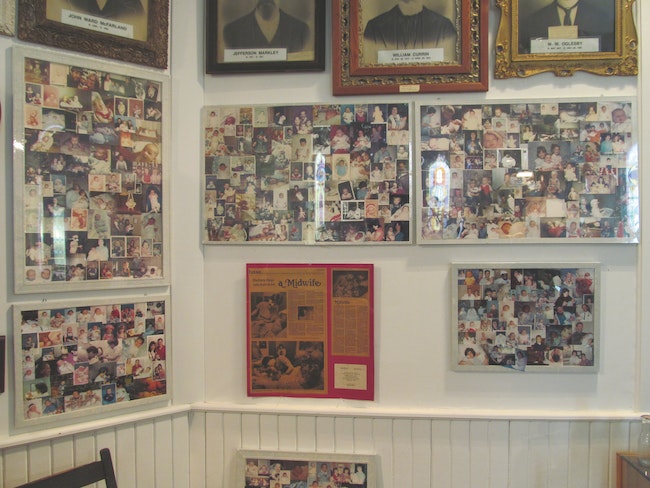
PART I
Cottage Grove has claims of being on the cutting edge of natural birth, and innovations that happened here first a century ago.
Shortly after World War I, Dr. S.M. Wendt set up his private Cottage Grove General Hospital upstairs in a building at 632 E. Main St., where the Rural Organizing Project office is today.
The building consisted of surgery, consulting, waiting rooms and eight patient examination rooms. It was there that Wendt pushed the radical notion that mothers should get up and move around the same day as their delivery. This was not in keeping with the practice of those times, when new mothers stayed in bed at least 10 days after birth.
Wendt’s ideas and innovations led to the establishment of Maternity Homes. From 1934-51, over 2,000 newborn Grovers saw their first light of day in these surprisingly modern surroundings, helped into the world by local doctors.
Lena Stockwell Veatch McFarland operated the first of these from her home at the corner of Ash and I streets.
In 1942 a family friend of Etta Butler requested to use her home so she could secure the services of a local doctor she trusted. After a few modifications to her home, it grew into a 10-year business for Butler.
On April 22, 1951, after 30 years of not having a hospital, the Cottage Grove Hospital opened at Birch and M streets.
Just two days later, the first baby was born in the gleaming, modern maternity department.
PIONEER DAYS
In the pioneer days, babies were born at home. If no doctor was available, often a neighbor or woman with experience would assist. Lucky indeed was a community that had services of a midwife.
“By 1900, about half of all American births were attended to by midwives. That began to change as the medical profession evolved and the medical model of childbirth was conceptualized, leading to a steep decline in the number of practicing midwives.
In 1915, Dr. Joseph DeLee, author of the most important obstetric textbook of the period, “Principles and Practice of Obstetrics,” described childbirth as a pathologic process that damages both mothers and babies “often and much.”
He said that if birth were properly viewed as a destructive pathology rather than as a normal function, “the midwife would be impossible even to mention.”
In the first issue of the American Journal of Obstetrics and Gynecology, DeLee proposed a sequence of interventions designed to save women from the “evils natural to labor.” The interventions included routine use of sedatives, ether, episiotomies and forceps.
This trend took many years to change its direction. (Sources: History of Midwifery, Judith P. Rooks, CNM, MPH, MS, 2012 and www.ourbodiesourselves.org/book-excerpts/health-article/history-of-midwifery)
REBIRTH OF MIDWIFERY
Many factors played into the rebirth of midwifery and a more natural childbirth. Feminism, the back-to-the-land movement, and ideas of the counterculture of the 1960s and 70s all helped move childbirth back to a more woman-center view of pregnancy and birth.
Without doubt, some interest arrived in the company of the folks who arrived in Cottage Grove hoping to form an intentional community at Cerro Gordo. Organizers hoped to create a vehicle-less utopia on the land around the local butte, Cerro Gordo.
Dr. Norm Schaeffer wound up in Cottage Grove through a process of elimination on a nationwide auto tour. When he finished his residency in obstetrics, he received a wide selection of offers to practice from Alaska to Guam.
In 1971, he and his wife packed up the car and checked out as many of the options as they could drive to. They liked Cottage Grove the most.
Taking a job at the Cottage Grove Hospital, he inherited a big innovation in birthing for the time — allowing the father to be present at the delivery. While this is a common option nowadays, it was unheard of at the time.
When he took over cases from a retired colleague, Schaeffer learned that the doctor had promised that the expecting fathers could be at the birth. The surprised Schaeffer decided to go along with it, and when it didn’t cause any difficulties, he made it part of his practice to offer this option.
This led to couples wishing to be together transferring their births to Cottage Grove. “Once I remember three in one day from Eugene and Springfield,” Dr. Schaeffer said.
When Schaeffer was assigned to be the supervising physician for Whitebird, an alternative healthcare provider in Eugene, word of the liberal policy of allowing fathers at delivery attracted over 1,000 counterculture families to select the Grove to bring their children into the world.
“Some of my staff were concerned when a guy who looked like he hadn’t had a bath in about six weeks walked in to pay on his bill with a stack of cash,” Schaeffer said. “They were worried I wouldn’t get paid, but as far as I can remember that never happened. They were an interesting bunch, but good people.”
Another innovation Schaeffer made toward a more natural childbirth was bucking the routine practice of giving the mothers a fairly large dose of painkillers automatically.
“I made it by request only, feeling that wasn’t in the best interest of either the mother or the child,” Schaeffer said. “I was the arbitrator of the baby, since all the others in the room had a voice, I felt I had to speak up for the unborn, having a big stake in the game but couldn’t speak for itself. If the pain was getting bad, I would encourage the mother to try and make a few more pushes before giving something for the pain. This was often enough for her to get through it without anesthesia.”
At that time in 1977, the infant mortality rate was about 14.6 per 1,000 nationally and around five per 1,000 in Cottage Grove. Schaeffer complimented the extraordinary nursing, pediatrics, and anesthesiologist team that had come together to make the Cottage Grove Hospital one of the best places to have a baby.
LUCINIA BIRTH CENTER
Dr. Tom Duncan came to Cottage Grove in 1976, in part to fulfill his dream of becoming a country doctor like his grandfather. After medical school and specialization in obstetrics, he worked on the Western Navajo Reservation.
“In the rest of America, women were having babies and not having a real good experience,” Duncan said. “They were being knocked out, heavily drugged and their babies taken away to the nursery as they were too out of it to care for them. Fear was heavily promoted to mothers-to-be with little education or unders.
“What I found among the Navajo was just the opposite,” Duncan said. “Sure, they came to the hospital to have their babies because there was food, water and showers, but they weren’t afraid and looked forward to having their babies. Midwives were a part of the scene helping the mothers through their births.”
Once in Cottage Grove, Duncan wanted to try home births, hospital births, and use everything he had learned.
Together, with midwife Irene Nielsen and a nutritionist, Duncan formed the Lucinia Birth Center, named after Lucinia, the goddess of childbirth protection in Swedish mythology. They set up in the building at 512 Adams Ave. Ruth Ann Duncan, his wife at the time, taught LaMaze classes at the center.
“We tried to be a place where the birth was as natural as possible, and believed that women needed to be cared for in all ways,” Dr. Duncan said. “Women were encouraged to do their part, not to be a puppet. The work was very demanding, but also very rewarding. One of the aspects of natural childbirth is that it doesn’t happen at a given rate. It may take many hours with false starts and pauses.”
That doesn’t fit in with hospital practice where time and room space are costly, Duncan said, so the trend was to hurry the mother, induce, or otherwise create pressure to complete delivery that happens in hospitals.
“So our birth center became very popular,” Dr. Duncan said. “We were very successful in many ways — except financially.”
Struggles both with the money and with some personalities would eventually cause the Lucinia Birth Center to close, but that is not the end of the story.
Next week’s column will chronicle how the emerging natural birth movement found a new home, pressured the medical community to make big changes, and the rebirth of the midwife model of pregnancy precare, birth, and post-birth infant care.
Reach Dana at [email protected]








